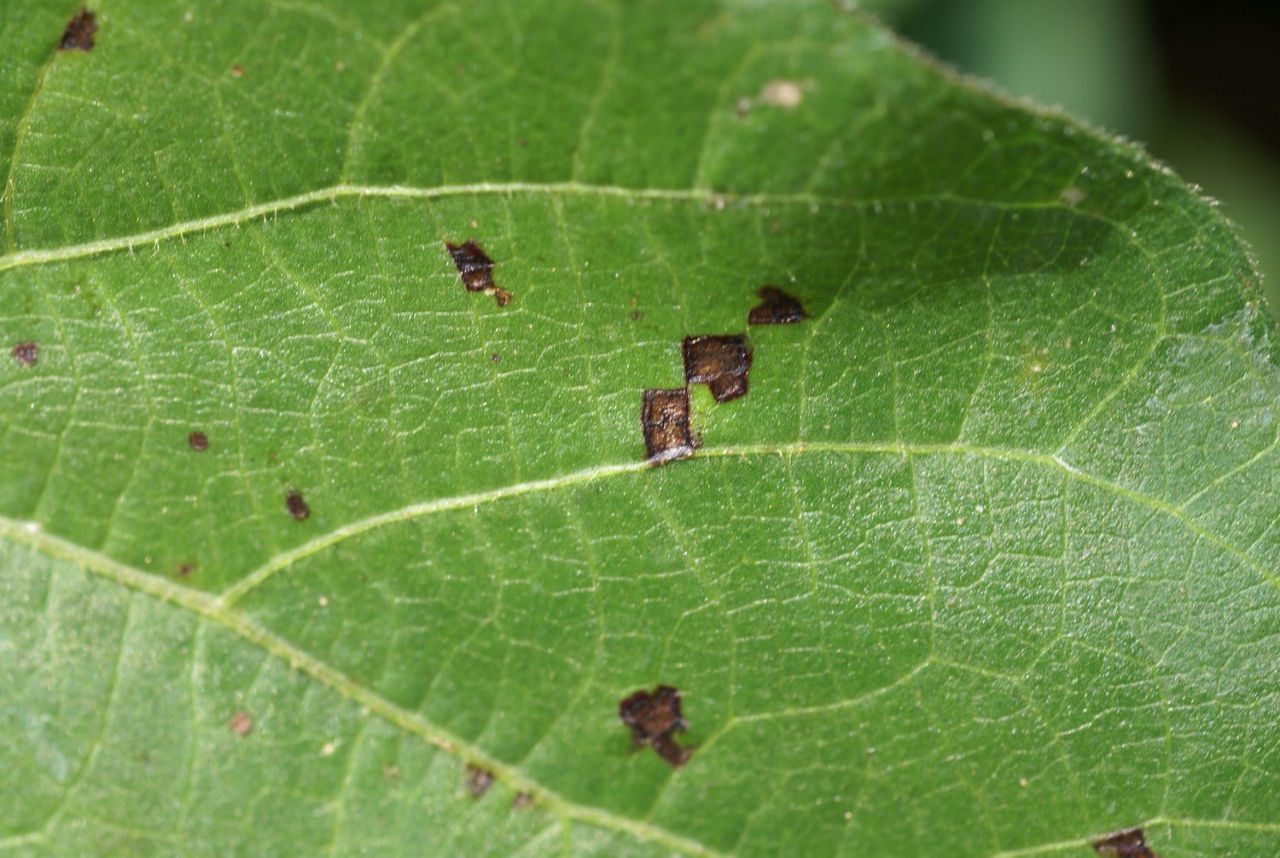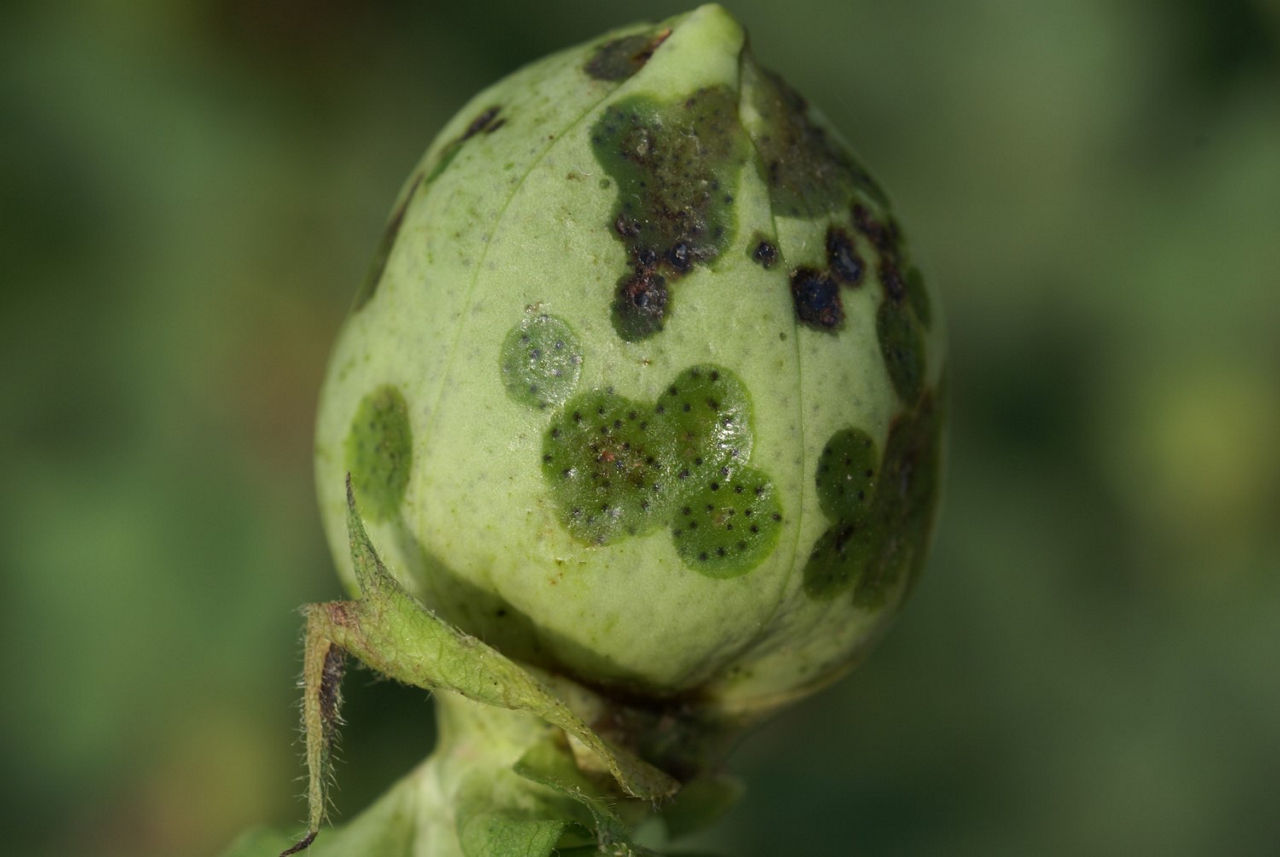3 MIN READ
Bacterial Blight in Cotton
September 12, 2024
Key Points
- Bacterial blight in cotton—also known as seedling blight, angular leaf spot, or black arm—is caused by Xanthomonas citri pv. malvacearum (formerly referred to as Xanthomonas campestris pv. malvacearum and Xanthomonas malvacearum).
- Before the initial release of resistant cotton products, bacterial blight caused severe damage throughout cotton-growing areas of the United States.
- Acid delinting of commercially available cotton seed has been very effective in reducing the potential for infection.
- The severity of this disease is greatly influenced by environmental conditions as the disease thrives in extremely warm and humid environments.
Symptoms of Bacterial Blight
In cotton, bacterial blight symptoms are first observed as small, water-soaked lesions that are noticeable on the upper and lower leaf surfaces. The lesions appear to be angular, as they are restricted by veins within the cotton leaf, and may have a red or brown border (Figure 1). Leaf tissue surrounding the lesion may also turn yellow, giving a “halo” appearance.1,2 Older lesions increase in size and can give the leaves a ragged appearance or cause premature defoliation. Other parts of the cotton plant may become infected following the production of secondary inoculum. The systemic spread of infection to leaf petioles, stems, and branches may result in black cankers (“blackarm” lesions) that can cause portions of the plant to die above the canker. Lesions on the bolls first appear to be water-soaked and round (Figure 3), and later become sunken and dark brown or black.1,2
Prior to the widespread commercial use of acid delinting of seed for planting, seedborne inoculum of Xanthomonas citri pv. malvacearum was reported to occur regularly. In recent years, bacterial blight has been commonly observed at low levels and reported in various cotton-producing regions. However, symptoms of bacterial blight will still be most severe and spread when relative humidity is high (>85%) and daytime air temperatures range from 86 to 100 °F along with nighttime temperatures in the range of 62 to 68 °F.3,4 The bacterium is capable of overwintering on plant debris. Wind, water, and thunderstorms can disseminate the bacterium beyond the initial point of infection. The pathogen enters host plants through open stomata or wounds. Blowing dust, wind-blown rain, overhead irrigation, and unsanitized equipment have been linked to bacterial blight epidemics.1,5



Additionally, bacterial blight inoculum may overwinter on weeds. In 2016, researchers conducted a field survey in which they collected seven weed species from four sites with a history of bacterial blight, and tested them for inoculum. Weed samples from three of the four sites tested positive for bacterial blight, indicating asymptomatic winter weeds remaining in a field could potentially serve as a source for bacterial blight inoculum in the following season.6
Management
Crop Rotation. Rotation to other row crops commonly grown in the cotton belt is an effective way to reduce disease pressure from bacterial blight. Other host crops that should be avoided include tomatoes, peppers, and rice.
Planting and In-season. Plant acid delinted seed of cotton products with resistance to bacterial blight. Scout fields on a regular basis to identify if any infection is occurring. While no fungicides are recommended for bacterial blight, growers may choose to apply growth regulators to prevent further rank growth of their crop. Dense rank growth can disrupt air flow within the canopy, creating a conducive environment for bacterial blight development. There are currently no products labeled for use against the disease. Because blight can disseminate rapidly in warm, wet conditions, any management practice to promote drying of cotton leaves may help reduce the development of blight.1
Limit the movement of equipment that may cause injury to plant tissues while foliage is wet, such as cultivators or sprayers, to reduce the potential spread of the pathogen in-season. Plan to harvest fields infested with bacterial blight as early as possible.
Post Harvest. Shred cotton stalks as soon after harvest as possible. The pathogen can survive on plant debris under relatively dry conditions for months, but turning the crop residue into the soil with tillage can promote decomposition.1,3
As a preventive measure, select cotton varieties with bacterial blight resistance the following year or plant to a different crop.
Sources
1Ahumada, D. 2017. Bacterial blight of cotton. North Carolina State Extension. https://content.ces.ncsu.edu/bacterial-blight-angular-leaf-spot-of-cotton
2Bacterial blight (angular leaf spot, black arm). University of Tennessee Institute of Agriculture. https://guide.utcrops.com/cotton/cotton-foliar-diseases/bacterial-blight/
3Kemerait, B., Allen, T., Rothrock, C., et al. Identification and management of bacterial blight of cotton. Cotton Incorporated. https://www.cottoninc.com/cotton-production/ag-research/plant-pathology/management-bacterial-blight-cotton/
4Boyd, M.L., Phipps, B.J. and Wrather, J. A. Cotton pests: Scouting and management. 2004. University of Missouri. IPM1025. https://extension.missouri.edu/publications/ipm1025/4
5Thaxton, P.M and El-Zik, K.M. 2001. Bacterial blight. In Kirkpatrick, T.L. and Rothrock, C.S., Eds. Compendium of cotton diseases 2nd edition. American Phytopathological Society.
6Koczan, J., Albers, D. and Gholston, K. 2017. Identification of an alternate source of inoculum causing bacterial blight. 2017 Beltwide Cotton Conference, Dallas, TX. https://www.cotton.org/beltwide/proceedings/2005-2022/data/conferences/2017/papers/17518.pdf
Web sources verified 09/04/24. 1411_62381
Seed Brands & Traits
Crop Protection
Disclaimer
Always read and follow pesticide label directions, insect resistance management requirements (where applicable), and grain marketing and all other stewardship practices.
©2024 Bayer Group. All rights reserved.